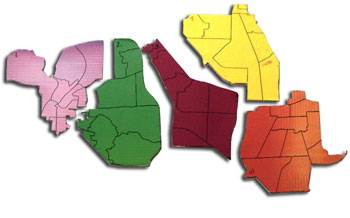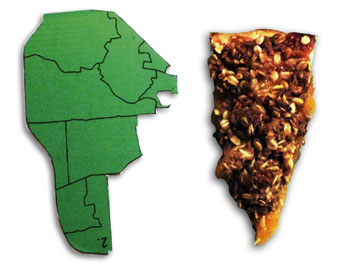Column: Pies, Politics, Polls
“Pie lovers … unite!”
As over 50 people throw their fists into the air, the contest resembles a superhero’s meeting more than a pie competition. On Sunday, July 24, Slow Food Huron Valley (SFHV) hosted its 5th annual Pie Lovers Unite! event at the Ypsilanti Ladies Literary Club. Most participants easily fit the “pie lover” label, considering themselves connoisseurs of crusts and aficionados of fillings.

Cardboard cutouts of the five wards of the city of Ann Arbor – not arranged in their actual geographic proximity to each other. (Photo for art by the writer)
But consistent with The Chronicle’s appetite for all things government-related, we could not simply let them eat pie. Instead, we brought handmade cardboard cutouts of Ann Arbor’s five wards and asked a roomful of pie enthusiasts which ward most resembles a slice of pie.
Why?
At its July 5 meeting, the Ann Arbor city council discussed redrawing the boundaries for the city’s five wards. And the city charter states: “The five wards should each have the general character of a pieshaped segment of the city with the point of such segment lying near the center of the city …” That discussion revealed that at least one councilmember holds some reservations about whether the current wards really are pie-shaped wedges of the city.
Kim Bayer, the program coordinator of Pie Lovers Unite!, began the night’s festivities by articulating the event’s mission beyond eating pie: “To strengthen our region’s food system, build community food security, and preserve our culinary heritage.”
She continued, saying, “When something is made from love, you can taste it.”
After a quick thank-you to the owner of Mighty Good Coffee, David Meyer, for providing the event’s coffee, Bayer addressed the audience: “What do you remember from last year?”
The pie lovers shouted back in unison, “PIE!” Then came individual murmurings – “pie-kus,” as the event’s pie-themed version of the Japanese form of poetry is known. And a piece of advice: “Pace yourself” – the evening includes feasting on pie.
Before beginning the sacred annual ritual of pie-ku reading, Bayer posed one more question to the audience about pie making: “Any secrets?” No one skipped a beat – the most popular one-word reply was butter, followed jokingly by lard.
While most bakers during the evening seemed to calmly accept approaches to pie baking different from their own, one idea provoked collective annoyance. Never, ever use margarine.
Then came the treasured tradition of reading the pie-ku contest submissions. To formally submit a pie-ku, public recitation is mandatory. About 10 minutes’ worth of pie poetry followed. Each pie-ku was structured in the same way as the Japanese haiku: three lines, arranged around a set number of syllables (five/seven/five). A sampling: “Blueberries it is/other fruits try to compete/my tongue says no way.”
After everyone recited their pie-kus and entered them for a chance to win a pie-related prize, the “pie-tinerary” dictated the next event – pie walks.
Similar to cake walks, each pie walk promised one lucky winner a free Zingerman’s pie. Not content with just one pie walk, organizers offered multiple categories: one for people who baked pies, one for children under twelve, one for the teachers of pie-making, for pie-making kids, for grandparents, and one for flapping like a chicken. (This writer’s flapping led to a delicious peach pie from Zingerman’s.)
By the end of the pie walks, anticipation was building. The pre-feasting festivities could only curb an appetite for so long. So finally, when Bayer headed up to the microphone again, she gave us a much-anticipated announcement – that we could slowly make our way to the pie-laden tables in the next room.
A smorgasbord of pies appeared – everything from adventurous goat cheese with tomato to a classic very cherry.
After about half an hour of pie-filled bliss, the judges filed out to announce the winners. The event offered six categories: fruit, sweet (non-fruit), savory (the non-sweet treats like quiche and pancetta), crust, local, and kids.
But before announcing the winners, the judges outlined two very serious (and somewhat contradictory) philosophies.
First, the idea of being “true to the fruit,” as one judge said, is paramount to any pie-maker. Allow it to keep its texture, its flavor – in short, don’t complicate things. “Bells and whistles don’t impress us,” one judge commented.
But, as some other judges mentioned, originality and creativity are also key. Innovation in pie-making is always appreciated. With those two philosophies in mind, the judges announced the winners of the 2011 Pie Lovers Unite! event.
First announced was the sweet non-fruit pie and the winner, as one judge put it, “was an awesome pie.” A buttermilk chess pie won the sweet non-fruit category.
Next up was the category for kid pie-makers. The judges called the entries “amazing,” and praised them for a precocious grasp of pie-making. The winning pie had “the perfect mixture of sweet and sour, crumbly and delicious” – a blueberry crumble. When the young pie-maker was asked about his inspiration for making the pie, he replied, “Blueberries.”
Crust was the next category, and the winner’s pie was “light and flakey” – a classic apple pie. Accepting his prize, the winner urged everyone to take crusts seriously, “Go with the crust category.” Then came the cardinal caution yet again: Do not skimp on the butter and never use margarine.
The savory category was for pies that could be eaten as meals, not desserts. A pancetta with caramelized onions won, and the judges commented on its “excellent flavor and smooth custard.”
The fruit category was up next, and it drew hushed voices and respect from the crowd. Similar to the “Best Movie” of the Oscars, the fruit pies are the most eagerly awaited. Of the 50 or so entries, Bayer estimated that 15 to 20 competed in the fruit category. The winning pie was “visually arresting,” and epitomized the judge’s philosophy of being true to the fruit. The winning pie “let the fruits be themselves.” A blueberry peaches pie took home the honor.
Last was the category dedicated to locavores, where the ingredients of each entry must be “local.” Only a handful of pies entered this category, but the judges stressed its importance: “I think it’s important to remember that essentially every ingredient in a pie can be found locally,” one judge urged. The winner was a crunch apple tart.
After the formal judging, the last award to be announced was a Peoples’ Choice Award. A wild black raspberry pie won the prize, and with that, the awards ceremony for the pies ended.
One last non-culinary prize remained – the winning pie-ku. Drawn from a hat was the following: “Crust shaped of fingers/Curved in and out, to and fro/Memories of Mom.”

A cutout of Ward 2, the ward voted the most pie-shaped, next to a piece of Zingerman's peach pie. Readers who are strict interpreters of the city charter will note a certain irony. (Photo for art by the writer)
Throughout the event, the pie chefs in attendance had a chance to tell us which Ann Arbor city ward they thought most resembled a pie-shaped wedge.
It may seem easy enough to point at a cardboard cutout of a ward and quickly announce a favorite in the pie-shaped ward contest. But most bakers scrutinized each choice.
Clarificational questions were asked: “Do you mean a slice of pie or a whole pie?” “Are you talking about the ward overall or does this include individual precincts?” And, a personal favorite from a confused passer-by, “What are you guys doing? Is this some sort of alien game? You’re so weird.” After much consideration, each pie-maker would point decidedly at one ward: “That one, definitely. Or at least that’s how my pie slices look.”
And the results were clear. Based on our polling, Ward 2 meets the city charter definition the best, while Ward 5 (which received zero votes) has a more questionable shape.
Editor’s note: The Chronicle is headquartered in Ward 5, which tallied zero votes in the poll. Note that the poll conducted on ward shape at the Pie Lovers Unite! event was unscientific and likely includes considerable margarine of error. On the Ann Arbor city council’s Aug. 4 agenda is a vote on the reapportionment of its wards. The staff-recommended tweaks on the Aug. 4 agenda are a little different from the changes presented on July 5. The specific changes have not been terribly controversial, but the timing was contested, and ultimately altered to be implemented after the November general election.
About the writer: Saline resident Hayley Byrnes is a Chronicle intern. The Chronicle relies in part on regular voluntary subscriptions to support our coverage of elections to public bodies like the Ann Arbor city council. Click this link for details: Subscribe to The Chronicle. And if you’re already supporting us, please encourage your friends, neighbors and colleagues to help support The Chronicle, too!







Margarine of error, ha ha!
I am so proud to live in the only true, pie-shaped ward. I would put it in the “savory” category.
Re: [2] As far as Ward 2 being the only true pie-shaped ward, I would point out – as the photo illustration makes clear – that Ward 2 achieved its status as most pie-shaped only by orienting its outer regions as the point of the pie slice. That contrasts with the charter’s description: ” … with the point of such segment lying near the center of the city.” So if anything, I would argue that Ward 2 is quite literally 180 degrees opposite of pie-shaped. ;-)
“I would argue that Ward 2 is quite literally 180 degrees opposite of pie-shaped.”
Dave
You clearly then must fall in the straight and narrow camp that must consume a piece of pie beginning at the ‘point’ and ending at the crust. What’s that you say? You didn’t know there was another choice.
Well yes, one can consume the pie beginning at the crust and ending with the point. But one must also then be wary of the laws where said pie is being consumed. It has been reported that some towns actually had laws prohibiting pie from being eaten crust to point.
Why would a town need a law like that? Imagine for a minute the council meetings deliberations that preceded passing such a statute.
Looks like there needs to be some re-districting to make the “points” of the pie slices near the ccenter of the city.